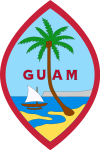Politics of Guam
This article needs additional citations for verification. (December 2007) (Learn how and when to remove this template message) |
 |
|---|
| This article is part of a series on the politics and government of Guam |
Guam is a two-party presidential representative democracy, in which the Governor is the head of government. Guam is an organized, unincorporated territory of the United States, with policy relations between Guam and the US under the jurisdiction of the Office of Insular Affairs.
Background[edit]
The economy of Guam is greatly dependent on the U.S. military bases there. The U.S. connection also contributes to Guam's status as a Japanese tourist destination.
Maintenance of the status quo vis-à-vis the current political relationship between the territory and the United States is controversial. There is a significant movement in favor of the Territory becoming a commonwealth, which would give it a political status similar to Puerto Rico and the Northern Mariana Islands. Competing movements exist, which advocate political independence from the United States, statehood, or a combination with the Northern Mariana Islands as a single territory (not necessarily commonwealth). These proposals, however, are not seen as favorable by the U.S. federal government, which argues Guam does not have the financial stability or self-sufficiency to warrant such status. They cite Guam's increasing reliance on Federal spending as evidence, and question how commonwealth status or statehood would benefit the United States as a whole.[citation needed]
A portion of the people on Guam favor a modified version of the current Territorial status, involving greater autonomy from the federal government (similar to the autonomy of individual States). Perceived indifference by the U.S. Congress regarding a change-of-status petition submitted by Guam has led many to feel that the territory is being deprived of the benefits of a more equitable union with the United States.[citation needed]. Guam is also listed on the United Nations list of Non-Self-Governing Territories.
No comments:
Post a Comment